|
'Ruler' Class
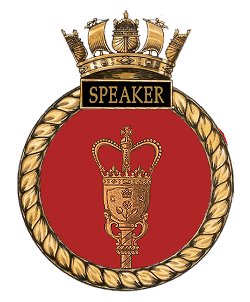
Description
Shape:
Standard, circular.
Blazon (Heraldic description)
On a red field: The head of the mace of the speaker of the House of Commons, gold.
SPEAKER: The chief officer and highest authority of the House of Commons. This design was originally produced for the Destroyer WHITBY, featuring the mace of her patron John Henry Whitley, Speaker of the House of Commons (1921-1938), but due to a typo the finished name was misspelt as WHITLEY. The design was reused for SPEAKER whose patron was Colonel, the Rt. Hon. Douglas Clifton Brown, the Speaker of the house (1943 – 1951).
For explanations of heraldic terms see the Badges & Honours page.
Motto:
"FACTA NON VERBA"
Deeds not words
|
|
Pennant Numbers:
D90
(Atlantic)
R314
& A453 (Pacific)
Battle Honours:
DOVER 1652
KENTISH KNOCK 1652
PORTLAND 1653
GABBARD 1653
SCHEVENINGEN 1653
SANTA CRUZ 1657
ATLANTIC 1944
OKINAWA 1945
|
|
|
Specifications
Builder: Seattle-Tacoma Shipbuilding Co. Tacoma, Washington
Completed by:
Willamette Iron & Steel, Portland, Oregon
Displacement: 15,390 tons
Length (Overall): 494ft 9in
Beam: 69ft 6in
Flight deck: 450ft x 80ft wood covered mild steel plate
Propulsion: 2 Foster Wheeler boilers; 1 x Allis-Chalmers geared
turbine driving 1 shaft
Speed: 16 knots
A/C Capacity: 20
Hangar: 260ft x 62ft x 18ft
A/C lifts: 2, Aft 34ft long x 42ft wide; forward 42ft long x 34ft
wide
Arrestor wires: 9 with 3 barriers
Catapult: 1 H4C hydraulic
Armament: 2 single 5in USN Mk 12, 8 twin 40mm Bofors, 14 twin 20rnm
Oerlikon, 7 single 20mm Oerlikon
Crew Complement: 646
Commanding Officers:
Capt P.W.Wootten
Oct 43 - Nov 43
Cdr the Hon.
R. Southwell, RN
Nov 43 - Jan 44
Capt. U. H. R. James
Jan 44 - Jul 46
Squadrons:
721 (Ferry)
Dec 45 - Jan 46
Vengeance TT
767 (DLT)
Nov 44
Barracuda II
768 (DLT)
Oct - Nov 44
Swordfish II & Barracuda II
1820 (DLT)
Oct 44
Helldiver
1840
Dec 44 - Apr 45
Hellcat
Listen to this section


Click here to see more photos
|
|
|
|
A History of HMS SPEAKER
|
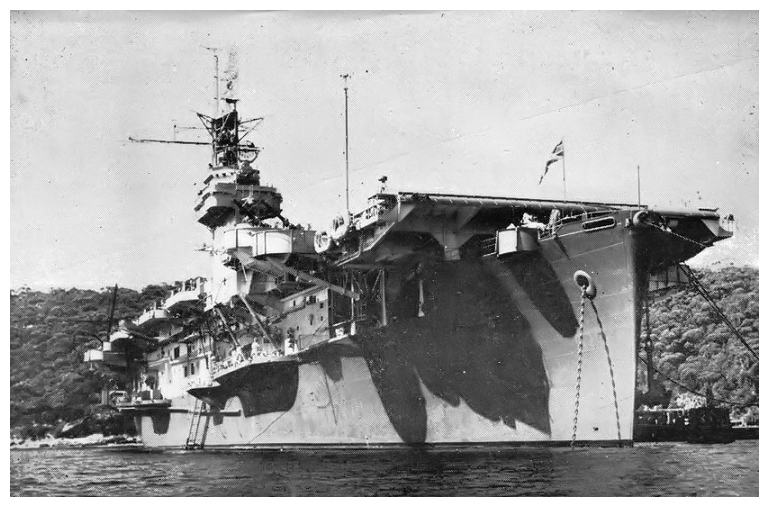 |
HMS SPEAKER at anchor Sydney 1945 Photo: from the
'History of HMS Speaker'.. |
Laid down on October 9th 1942 at Seattle-Tacoma Shipbuilding Co. Tacoma, Washington, as a C3-S-A1 type freighter, Maritime Commission hull number 251, Seattle-Tacoma hull number 35 the hull was purchased by the US navy, to become DELGADA ACV-40. Whilst still under construction it had been decided that ACV-40 was to be transferred to the Admiralty on loan on her completion as an aircraft carrier. After 134 days on the Ways her hull was launched on February 20th 1943 by her sponsor Mrs. James B. Sykes, and was assigned to Willamette Iron & Steel, Portland, Oregon, for the completion of her construction as an escort carrier. She was to spend the next 273 days under construction in the water. On July 15th 1943 her USN designation was changed from ACV to CVE.
An advance party of her RN crew, sailed from the UK in the spring of 1943, landing at New York; they were temporarily accommodated at RN Camp Peekskill, New York state, before crossing the US by train to Portland. Once at Portland they were billeted ashore until the ship was sufficiently outfitted to accommodate personnel on-board.
CVE-40 sailed on her builder's sea trials and Admiralty acceptance trial one day in early November 1943; leaving the quayside at 08:00 the acceptance trial was carried out by a four man board of naval officers who re-check the findings of the Builder's trials and more. Rear Admiral Noyes USN headed the trial board two captains and a lieutenant-commander completed the board. Also present on board for these runs were the RN officers and crew, and a big force of Willamette Iron & Steel corporation workmen, Commander Leiand D. Whitgrove, the local supervisor of naval shipbuilding, together with members of his staff, and a group of Willamette officers.
After passing down the Willamette River she entered the Columbia River and trials began at 09:00. The first test was a full power run and speed run over a measured mile, downstream, turning around at 10:40 and repeated the runs upstream completing her maximum speed run over a measured mile commencing at 13:20 with an emergency stop. After testing her anchors, steering, engines, and general handling she returned to her berth at 16:00 after completing the test schedule.
On completion of defect rectification and final fitting out, a total build time of 407 days, CVE-40 was delivered to the US navy and transferred to the United Kingdom at a ceremony held on the flight deck on November 20th 1943. The ship was accepted from Willamette Iron & Steel on behalf of the US Navy by Captain L. D. Whitgrove USN, and after the playing of the American national anthem he delivered her to Commander the Hon. Robert Southwell RN who accepted her on behalf of the Admiralty. CVE-40 was commissioned into RN service in a short ceremony when Commander Southwell read out the commissioning warrant and the ship was named HMS SPEAKER. The Ship’s company were called to attention and honour guard was called to present arms as the White ensign and the Union Jack were hoisted while the British national anthem was played. A short church service followed. Also in attendance was Lieutenant Commander Henry Gardner RN, the British Liaison Officer for the Port of Portland and senior corporate officers from Willamette Iron & Steel Corporation. This was the third escort carrier the yard had completed for the RN.
|
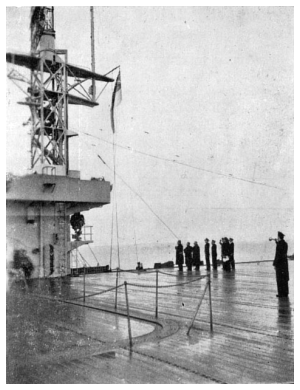 |
Commissioning and transfer ceremony at Portland, Oregon.
Photo: from the History of HMS Speaker.. |
Modification and preparation to enter service: December 1943 - February 1944
HMS SPEAKER sailed from Portland on December 6th 1943 bound for Vancouver, Canada to be modified to meet Admiralty requirements, receive her full crew compliment (SPEAKER had only a skeleton crew drafted to her at Portland due to manpower shortages), and work up ready for beginning her active service. This work was undertaken by the Burrard Dry Dock Co. Ltd., North Vancouver, British Columbia. SPEAKER was the eighth ship to be modified by Burrards: She was due at Vancouver on November 30th but due to hold ups she arrived on December 7th and anchored in the stream off, Lapointe Pier. At this time sister CVEs
EMPRESS,
SHAH,
NABOB and
PREMIER were in the hands of the Burrard's yard and at various stages of modification. During this period the ships company vacating the ship; Officers lived ashore and the crew were accommodated aboard HMS
THANE which was acting as an accommodation ship at that time.
Work commenced to de-store the ship and her alteration work began
the following day: this work totalled 150 separate modifications and
included lengthening of the flight deck, fitting redesigned flying
controls and fighter direction layout, modifications to hangar,
accommodation and store rooms, installing extra safety measures
including major changes to the aviation fuel stowage and oiling at
sea arrangements,, modifying gunnery and other internal
communications, adding extra W/T and R/T sets, and improved darken
ship arrangements.
As work progressed SPEAKER moved through the yards various berths; the yard could be working on six different ships at any time with separate aspects of the work carried out at different berths, the ships passing through like a production line, moving from one berth to another until complete. SPEAKER moved into No 4 berth on December 10th, from there she entered Burrard' s floating dry dock on December 20th for the fitting of additional sea valves and other remedial work and on undocking on the 23rd she was secured alongside in No 3 berth. She returned to No. 4 berth on December 28th, where on January 3rd a replacement Low pressure turbine arrived; all of the class suffered from defective LP rotors and they required re-milling of the gear teeth by the manufacturers to correct the problem. Later ships had the problem resolved at the Seattle-Tacoma yard or in Portland, but SPEAKER and earlier delivered vessels had to be corrected while in Vancouver. She moved into No. 5 berth on January 16th where her alterations were to be completed on January 25th 1944. The engine room work was not completed until the 28th when she was moved to No. 7 berth and her engines were tested. Including holidays, SPEAKER spent 49 days in dockyard hands; she was moved to a mooring in the stream the following day.
|
 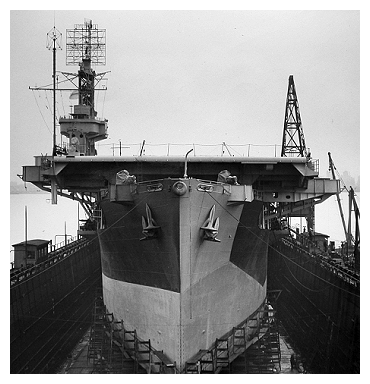 |
Examples of some of the tasks undertaken at the
Burrard's dockyard in Vancouver. Right; a CVE in the
floating dry dock. Left; the flight deck is being
extended to maximise take off run, note a sister carrier
undergoing work in another berth. Photos: Ronny
Jaques / National Film Board of Canada. Photothèque /
Library and Archives Canada. |
Although the alteration phase of her work was now complete SPEAKER was still undermanned, during January the crew began to arrive, including the commanding officer Captain U. H. R. James, and Lieutenant Commander `Flying', Lt Cdr H P Allingham RNR, however many key personnel had still to arrive, including engine room staff. SPEAKER was not sufficiently crewed for putting to sea until February 8th. SPEAKER departed Vancouver for the Puget Sound Navy Yard, Bremerton, Washington on the 10th where she was to take on ammunition between the 11th to the 14th after which she refuelled at Manchester, Washington and anchored there overnight. She returned to Vancouver on the 16th to conduct gunnery, radar and other trials and exercises in the Straits of Georgia (between Vancouver Island and the mainland). On February 23rd the ship sailed for Esquimalt, Victoria, North Vancouver to embark Confidential Books and make final preparations to leave for the UK.
Maiden voyage: Ferry trip to UK: March 17th
- April 8th 1944
SPEAKER sailed from Esquimalt as an operational carrier on
February 24th 1944, and headed for the Panama Canal, and the
Atlantic Ocean. After passing through the Panama she reached Canal
on the Atlantic side on March 8th. There she met up with up with the CVEs HMS EMPRESS and USS TULAGI, 2 USN destroyers and 2 RCN
corvettes. This group of vessels proceeded to sail on the 11th in
convoy to Norfolk, Virginia, arriving there on March 18th. While on
rout to Norfolk an Avenger from EMPRESS' 850 squadron operated
with SPEAKER giving the ship's flight deck parties and air
department their first experience of deck landings and take-offs.
SPEAKER and EMPRESS spent the next week at
Norfolk dockyard for repairs to defects left outstanding from
Vancouver and those that had developed on route to be carried out.
Once her repairs were completed SPEAKER was allocated to Western
Approaches Command for duty as a ferry carrier and preceded to New
York, arriving at Staten Island on March 25th to collect a ferry
load of aircraft for passage to the UK. A total of 82 airframes,
some crated, were embarked together with 54 passengers, these
included the wives and children of servicemen, Captain James's wife.
SPEAKER, in company with EMPRESS sailed f on March 28th in the
Liverpool bound convoy CU 19. On reaching the Irish coast the two
carriers split from the convoy, EMPRESS made for Greenock on the
Clyde, while SPEAKER headed for Liverpool arriving on April 8th;
SPEAKER was berthed at Gladstone Dock to off load her aircraft and
passengers. Aircraft were unloaded through the night of the 9th, but
the ship had to move out of the dock to an anchorage to complete the
task owing to the berth being required.
|
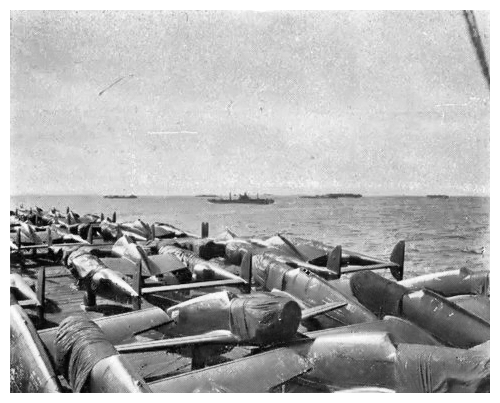 |
SPEAKER on ferry duties, her hanger and flight deck
crammed with American airframes. Photo: from
the 'History of HMS Speaker.'. |
Ferry trip Norfolk to UK: 13th April - 17th May 1944
SPEAKER was to be employed in the ferry role for the first part of
her operational career. She left Liverpool on April 10th for the
Tail of the Bank, Greenock to refuel and store ship and wait to join
a west bound convoy for a voyage to Norfolk, Virginia. She
sailed from Greenock with convoy UC19 on April 13th; on nearing the
US coast SPEAKER detached from the convoy and made for Norfolk Naval
Operating Base to collect a number of British airframes from the
Norfolk air station on the 24th before proceeding to Staten Island.
While alongside at Norfolk the Captain and Commander took the
opportunity to fly out to visit the DLT carrier USS CHARGER
operating in Chesapeake Bay, to have a look at what SPEAKER might
shortly be expected to be doing.
On arriving at Staten Island on the 27th more
aircraft and cargo were embarked and the ship was presented with a
set of band instruments and gramophone records; these were the kind
donations of Mrs. Tenney and Mrs. Baker of New York. After taking on
passengers SPEAKER sailed for Liverpool with convoy CU23 which
departed New York on May 3rd. The convoy arrived at Liverpool on May
14th, and after disembarking planes and passengers SPEAKER returned
to the Clyde and berthed in the Gareloch on 17th to await further
orders.
Fitting out as assault carrier: May 18th to
September 11th 1944
HMS Speaker was one of a number of CVEs selected for conversion into
an 'Assault Carrier' one a new type of ship to be used to
provide air support for major military landings. The assault CVE
would provide air cover until shore base air strips became
operation. New orders arrived shortly and SPEAKER sailed for Dundee
on May 26th, arriving at the Caledon Shipbuilding Company for her
conversion work to commence on 28th.
This involved many new pieces of equipment being
installed; a new type 277 radar, a new telephone system consisting
of over 100 telephones, new a new Briefing Room and `Army Plot' Room
and cabins added around the 'Aircraft Direction Room' and
numerous other additions such as extra W/T and R/T sets and still
further improvements to the bridge. Another important modification
was an anti-aircraft armament upgrade; all existing single Oerlikon
mounts on the Gallery Deck and foc'sle deck, were to be changed for
fourteen powered twin mountings.
While at Dundee SPEAKER's crew complement was
adjusted, the Admiralty decided that assault carriers should be
entirely manned regular RN personnel; engine room and supply
department positions were normally filled by T124X personnel and
these were drafted to other ships. (SPEAKER was the first and only
CVE that this change over was completed). Accordingly Lt. Cdr. (E) Cutlack, R.N.R., and Lt. Cdr. (S) H. R. Newton, R.N.R., joined as
"Chief engineer" and "Paymaster" with new staff. Also at that time
Surg. Lt. Cdr. J. G. Bryson, R.N.V.R., joined her as P.M.O. and Lt.
Cdr. A. Darley as "Commander Flying". The ship was also to receive
some army personnel in the form of an Army Liaison Section. 140
extra bunks built in the ship to accommodate the inevitable increase
of complement that her new role demanded, together with extra
ventilation, racks, hooks and lockers, re-arrangement of and
increase in the number of bathrooms and heads. In all the ship
received nearly 350 modifications in addition to the 150 done in
Canada.
During the conversion period Captain James made a
visit to the House of Commons to pay his respects to the ship' s
patron the Speaker of the house (Col. the Rt. Hon. Douglas
Clifton-Brown) to give him news of the ships progress. The Speaker
later presented the ship with a gift of a silver cigarette box which
was delivered by his Secretary, Sir Ralph Verney, on a reciprocal
visit to the ship in Dundee.
Rosyth and DLT duty: 12th September to 14th
December 1944
After sixteen weeks at the Caledon yard Speaker left Dundee and went
to Rosyth. On arrival there she was back in dockyard hands for the c
completion of a few items which Dundee had been unable to finish and
once the work was done carry out a post conversion shake-down. On
October 16th SPEAKER was ordered to operate as a Deck Landing
Training carrier based at Methil in the Firth of Forth for a six
week period, to fill in the gap while her own squadron,
1840 NAS,
completed their work up in the army co-operation role in Northern
Ireland.
|
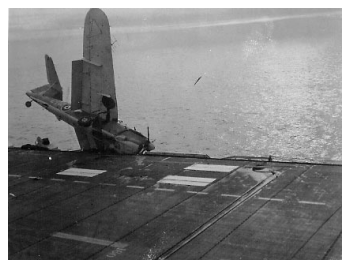 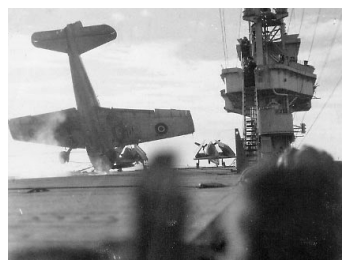 |
Practice makes perfect. Left; a Barracuda slips sideways
and falls into the walkway and eventually into the sea.
Right; a Hellcat perched on it's nose after taking the
barrier. Photos: from the collection of John Bryden
Watt, via Navsource. |
Between October 16th and November 28th Swordfish
and Barracuda aircraft from 768 Squadron flew out to the carrier daily
to practice deck landings; also Barracudas from 767 Squadron conducted
training during November 3rd to 27th. SPEAKER was also one of the
few carriers to operate the Helldiver aircraft of
1820 Squadron which
carried deck landings on October 29th; the type was not considered
as suitable and never used operationally. This period put the
ship's air department thoroughly through their paces, in total
1,460 deck landings were made, including 160 in one day alone; there
were eleven deck crashes.
Allocation to the British Pacific Fleet:
December 1945
On being relieved of DLT duty SPEAKER left Rosyth for Lamlash Bay on
December 14th 1944; on this date Commander Viscount Southwell, left
the ship, he was relieved by Acting-Commander W. C. Hudson, R.N. The
ship arrived off Northern Ireland on the 16th to embark the
personnel and 24 Hellcats of
1840 squadron from
RNAS Ballyhabert.
1840 was to be assigned to SPEAKER for operations in the Army
Co-operation role as well as normal fighter squadron duties. SPEAKER
was ordered to join the newly formed British Pacific Fleet in
Australia and preparations began for her departure in the New Year.
Embarkation of aircraft was hampered by the bad weather and one of the first to attempt to land on the ship on the 18th (JV204 flown by Sub-Lt. ES Sparring, RNVR) had its arrestor hook knocked off on the rounddown, and the aircraft crashed into the barrier and fetched up in the walkways. The aircraft was a write off and the incident required some hours of work to get the aircraft inboard before embarkation could continue. On the following day there was a second barrier crash (JV248 flown by Sub-Lt. MG Gatley, RNVR) when an aircraft missed all the arrestor wires; this incident was not as serious and flying resumed in short order. The weather remained settled and the squadron was able to fit in five days of deck-landing and flying drill before the ship had to go Greenock on the 23rd, when the Squadron flew ashore to
RNAS Abbotsinch. Speaker was to undergo a short period of defect rectification and sailed up the Clyde to Glasgow and entered dock on Xmas Day. Both squadron and ship's company were granted Christmas leave.
On return from leave
1840 squadron moved to
RNAS Ayr on New Year's Eve 1944 where the remaining Hellcat Mk.Is were withdrawn and new rocket equipped Mk.IIs were issued, the squadron flew out to re-join SPEAKER later that day. The next eleven days were spent conducting an intensive work up in preparation for the ships departure to join the British Pacific Fleet. SPEAKER suffered her first fatality on Wednesday, 3 January 1945 when D/JX 226824 Leading Seaman Robert Peel went missing, presumed lost overboard.
On passage - Greenock to Colombo: January
11th to February 4th 1945
On January 11th 1945 SPEAKER, in company with the CVEs
KHEDIVE and
SLINGER (under command of Captain B. L. Moore, Senior Officer) and
three escorts sailed from the Clyde bound for Alexandria on the
first leg of passage to Australia. The group of ships reached
Alexandria on January 22nd, and entered the Suez Canal on the 24th
for transit to the Red Sea.
Intensive flying operations had been undertaken
during the passage across the Mediterranean, which allowed the
squadron more practice since the usual six week squadron work up had
not been possible before the ship's departure from the UK. Little
was achieved before passing Gibraltar as weather conditions
prevented safe flying. Some operational sorties were flown on
January 17th by aircraft from SPEAKER and
SLINGER to search for a
U-boat reported off the North African coast and this would have been
an opportunity for the use of the new rocket equipped aircraft;
nothing was found however and flying reverted to training sorties
(KHEDIVE could not launch aircraft as her flight deck was covered
with a ferry load of airframes for delivery to Ceylon).
The small convoy reached Alexandria on the 22nd
stopping briefly before continuing on to Port Said the same day.
Late on January24th SPEAKER weighed anchor to pass through the Suez
Canal and on into the Red Sea; here transit of the canal was broken
with a night at anchor in the Bitter Lake, the ships passed by the
two Italian battleships, VITTORIO VENETO and ITALIA, who had been
anchored there since the Italian surrender.
|
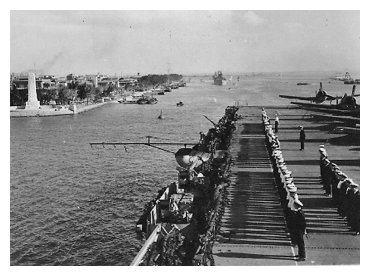 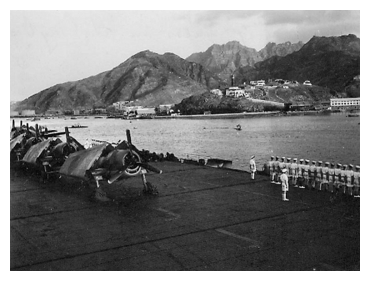 |
HMS SPEAKER exiting the Suez Canal (left) and passing
Aden on the Red Sea 9Right) aircraft from 1840 squadron
are ranged on deck. Photos: from the collection
of John Bryden Watt, via
Navsource. |
After a brief stop at Aden to refuel and store ship on January 28th SPEAKER and company steamed straight across the Indian Ocean to Colombo, arriving there on February 4th. By the time SPEAKER reached Colombo her squadrons intensive flying work up had resulted in 2 lost and 4 damaged aircraft and one pilot had been killed: Aircraft losses were JW894 flown by Sub-Lt. B Jacques, RNVR, which spun into the sea while carrying out fighter tactics in the Red on January 25th, killing the pilot, his aircraft vanished before any of the escorts could reach the impact site. A second, JW876 flown by Sub-Lt. JO Boon von Ochaeo RNeN, ditched while returning from
RNAS Colombo Racecourse on February 3rd, the pilot was rescued. Two aircraft suffered barrier crashes and were badly damaged, two others suffered from deck pecking, the aircraft pitching onto its nose and damaging the propeller. Unserviceable aircraft were exchanged at Colombo to bring the squadron back to strength. .
On passage - Colombo to Sydney: February 6th
to 23rd 1945
At Colombo the three CVEs were to part company, SPEAKER and
SLINGER
departed for Sydney on the 6th, while
KHEDIVE remained in Ceylon to
join the strength of the East Indies fleet. On February 8th the
traditional 'crossing the line' ceremony was observed aboard SPEAKER
and
SLINGER which had crossed the equator at 21:00 hours the day
before; the festivities took up most of the day with nearly 800
' victims' being initiated. The celebrations were soon forgotten
though as on February 11th both ships were called to assist in a
search for survivors from a torpedoed American troop ship, the S.S.
PETER SILVESTER, 1000 miles off the coast of Western Australia.
Aircraft from both carriers conducted aerial searches but after five days no trace was found; SPEAKER continued on to Sydney leaving the area late on the 16th,
SLINGER remained to continue searching until the 19th before she too had to break off and proceed to Sydney. 1840 squadron was to lose two aircraft during the search; on the 14th Hellcat JX750 flown by Lt FC Buckley RCNVR, drifted to port on landing and hit the deck heavily, it was written off and jettison overboard the following day. On the 16th JW888 flown by Sub-Lt. R.T. Bell RNVR, hit the rounddown after making too fast an approach and crashed into the sea; the pilot was rescued. SPEAKER arrived at Sydney on February 23rd, flying off 16 of her remaining Hellcats to
RNAS Schofields (MONAB III) before entering the harbour. She was secured at a berth at dolphins, near Taronga Park (the Zoo) in Snails Bay.
Operations with the BPF: At Sydney and passage
to Manus February 23rd to March 13th 1945
The remaining eight aircraft and their pilots were transferred
to HMS INDOMITABLE to bring her air group up to strength. SPEAKER
was to retain her squadron, although it was to remain at the reduced
strength of 16 aircraft as it had been decided that she would be
operated as a CAP (Combat Air Patrol) carrier providing air cover
for the replenishment area ships of the Fleet Train.
While at Sydney 48 hours' leave was given to each watch, and arrangements were made for a hasty boiler clean and essential repairs to be carried out before the ship began loading stores and personnel for her first voyage with the B.PF. The Commander-in-Chief British Pacific Fleet, Admiral Sir Bruce Fraser, G.C.B., K.B.E., paid a visit to SPEAKER and explored the hangar and galley and spoke to many officers and men. SPEAKER'S Commander, Commander W. C. Hudson was hospitalised during the time in Sydney; he was invalided to shore service, and had to be left behind. This situation left the Commander Flying, Lt. Cdr. Darley and the First Lieutenant Lt. Brereton to share the executive duties for the foreseeable future as no replacement could be provided at such short notice.
SPEAKER sailed the Fleet Train on March 9th 1945,
bound for Manus in the Admiralty Islands, on board were the advance
party of
HMS NABARON, Mobile Naval Air Base (MONAB) No.4 comprising of 6
Officers and 57 ratings, together with the second echelon of
Maintenance, Storage & Repair unit (M.S.R.) No. 4 which were to be
delivered to
Ponam Island
in the Admiralty Islands. Shortly after clearing
the Jomard Passage (a 3-mile wide gap in a 300-mile stretch of coral
reefs and islands extending eastwards from the tip of New Guinea),
which was navigated entirely using the ship's radar due to
visibility being down to one mile, the ship intercepted an S.O.S.
from the USS ROBERT SYLVESTER, She reported being aground on Vassee
Island and pounding badly, giving their latitude and longitude. This
information fitted in with a D/F bearing of her signals and was
found to be an island about 30 miles ahead on SPEAKER's route, and
close to where she was expecting to be joined by an escort
consisting of the sloop PHEASANT and frigate PARRETT. On reaching
the area two Hellcats were launched to begin an air search while the
PARRETT began a search pattern along the edge of the reefs in the
area. No trace was found after several hours searching and SPEAKER
resumed her passage to Manus that evening leaving the PARRETT to
continue searching: The survivors were eventually located ten days
later, 75 miles from their estimated position given in the SOS, they
had been to the south-east of SPEAKER on the coast of New Guinea
instead of the north-west off New Britain.
SPEAKER arrived at Ponam on March 13th and the
MONAB personnel were disembarked to begin unloading the S.S. CLAN
MACAULEY together with 3 months victualling stores which were also
awaiting their arrival, which where aboard the Victualling stores
carrier S.S. FORT EDMONTON. When unload was finished SPEAKER
anchored in Seeadler harbour on the 15th and was allocated to 30 ACS
(30th Aircraft Carrier Squadron) for operation with the Fleet Train, Task Force 112. Her captain reported to RAFT
(Rear-Admiral, Fleet Train) Rear-Admiral D. B. Fisher, C.B., C.B.E.
aboard LOTHIAN and Commodore W. P. Carne, commanding 30th Aircraft
Carrier Squadron aboard the CVE
STRIKER.
Operation ICEBERG I replenishment at sea: March 18th to April 23rd
After restoring and fuelling advance elements of the Fleet Train
sailed from Manus on March 17th in order to have a Tanker Group in
position for the BPF to top up with fuel at the last prudent moment
before embarking on the forthcoming strikes against the island of
Okinawa 'Operation Iceberg I'. The ships were formed into two Task
Units which were to proceed directly to the prearranged rendezvous;
TU 112.2.1 consisted of H.M. Ships
STRIKER (with replacement
aircraft), CRANE, FINDHORN, WHIRLWIND and the Tankers SAN AMBROSIO,
CEDARDALE and SAN ADOLPHO and. TU 112.2.5 consisted of H.M. Ships
SPEAKER (for CAP duties), PHEASANT and KEMPENFELT.
A second convoy of logistic support ships,
comprising of LOTHIAN (flag ship Rear-Admiral, Fleet Train),
SLINGER, EMPIRE SPEARHEAD,
ARTIFEX,
BACCHUS, WAVE KING, WAVE
MONARCH, ARNDALE, DINGLEDALE,
FORT COLVILLE, AASE MAERSK,
DENBIGHSHIRE, ROBERT MAERSK, THYRA S., HERMELIN, and TYNE, which
left Manus on March 19th bound for the Philippines. The convoy
arrived at Leyte Gulf on the 26th and anchored in San Pedro Bay.
For SPEAKER Flying practice was the order of the
day once the anchorage at Manus was behind them but a heavy swell
meant that little flying was done due to safety concerns; in fact
severe sea states prevailed and prevented any unnecessary flying;
four flying accidents had occurred on route to the rendezvous and as
1840 had only 16 Hellcats and would be expected to launch flights of
4 aircraft for each CAP sortie, with an additional fifth aircraft
ranged on the catapult ready to launch at all times, the risk of
damage or loss of aircraft or aircrew meant minimal flying was
carried out until such time as CAP sorties were required.
Replenishment period 1, March 25: Task Force 57 met with the Logistic Support Group (LSG) at 06:00, Task Units 112.2.1 and 112.2.5, at position ANT, (18° 3o’N 129° 08’E), for a short replenishment at sea on the 25th which included the issuing of 4 replacement aircraft from
STRIKER and topping off fuel tanks. SPEAKER began her CAP duties in earnest. Fuelling was completed by 15:30.
On completion of this topping off TF57 joined US Task Force 58 on the 26th for joint attacks on islands of the Sakishima-Gunto group in support of preparations for US landings on Okinawa. This was the first of 12 strike sorties against Japanese airfields on the Islands of the Sakishima-Gunto group in operation ICEBERG One. Because of the long distances involved between the operational area and the nearest forward base, all replenishment had to be done at sea; TF57 was operating a strike cycle of 2 days on station followed by 2-3 days of replenishment.
|
 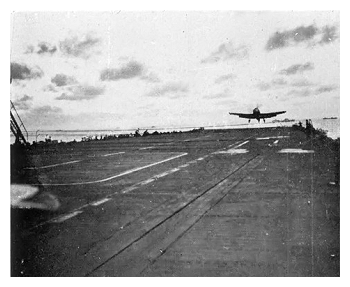 |
Left: The Hellcats of 1840 squadron ranged on deck.
Right: The Combat Air Patrol return to the ship at dusk.
Photos: from the 'History of HMS Speaker'.. |
With the departure of the fleet the ships of the logistic support group moved to refuelling area MIDGE on the 28th. There were three areas used for fuelling, each was a rectangular area which covered 5000 square miles of ocean east of Luzon, their code names were all called after insects; each area was 50 miles to the south and 100 miles west of' the following positions – 'COOTIE' 21° 52’ N 129° 24’ E; 'MIDGE' 19° 55’ N 129° 40’ E; and ‘MOSQUITO' 20° 17’ N 125° 22’ E. The nominated area changed from one replenishment period to the next.
Replenishment period 2, March 28 - 30: The Logistic Support Group were waiting at the prearranged rendezvous, in area MIDGE at 07:30 on the 28th. TF57 met the Tanker Group and began refuelling. On the mornings when the fleet returned to rendezvous, SPEAKER had to be ready to fly off the first CAP sortie at first light, and keep four aircraft airborne till dusk, in two-hour sorties. At night the task force left the refuelling area and steamed independently at higher speed for safety against submarines, re-joining the logistic support group at dawn for a second day's fuelling. Due to their only being 3 Tankers on station and leaking hoses refuelling continued into a third day, completing at 14:30 on the 30th. During this replenishment period
STRIKER issued 13 replacement aircraft to the fleet and recovered three flyable, but unserviceable, aircraft; in addition she transferred replacement Avenger aircrew to 854 Squadron in ILLUSTRIOUS. There was one flying incident for 1840 squadron, on the 30th Sub-Lt W. Percy, RNZNVR flying in JX792 entered the barrier after his hook was pulled out when it struck the rounddown.
Replenishment period 3, April 3 - 5: Bad weather hampered the rendezvous on April 3rd, which was not made until 13:20. Between the 3rd and the 5th of April, Task Force 57 took on fuel and stores. For this replenishment period there were two CVEs in the LSG, SPEAKER with her 1840 CAP Hellcats for the LSG and SLINGER which provided replacement aircraft and aircrews; she issued 22 replacement aircraft to the fleet carriers and recovered 2 ‘flyable duds'. The fleet repositioned overnight on the 4th to replenishment area MOSQUITO One and refuelling resumed at 06:30; a second Tanker group TU112.2.3 also arrived from Leyte bring the total to 5 Tankers on station. The Fleet disengaged at 19:30 for the night. Fuelling resumed at 06:30 on the 5th in better weather, and replenishment was complete by 19:30 when the Fleet disengaged and sailed for the operational area.
Replenishment period 4, April 8 - 9: At 06:00 on the 8th TF57 met the LSG in replenishment area COOTIE One. 1840 squadron again provided CAP for the LSG while
STRIKER provided replacement aircraft and aircrews.
STRIKER issued 13 replacement aircraft and recovered 4 flyable but unserviceable aircraft and provided one Avenger crew to 854 squadron. Replenishment was completed by 15:50 on the afternoon of the 9th and TF 57 left COOTIE One to return to Sakishima.
Replenishment period 5, April 14 - 15: At 05:30 on April 14th the LSG and the Fleet Carrier FORMIDABLE rendezvoused with TF 57 in replenishment area Cootie (1). The Tanker Group consisted of 5 oilers with SPEAKER providing CAP aircraft over the replenishment area. The carrier FORMIDABLE, with destroyers KEMPENFELT and WESSEX were waiting and joined Task Force 57, relieving ILLUSTRIOUS which sailed for Leyte at 17:55 screened by URANIA and QUALITY. Replenishment continued on the 15th, but no replacement aircraft were available during this replenishment period; SLINGER should have been on station but a serious propulsion defect meant she was order to Brisbane for repairs. FORMIDABLE was at full strength however, carrying 848 Squadron’s 18 Avengers along with
1841 and
1842 Squadrons - each with 18 Corsairs. SPEAKER’s squadron had a second barrier crash on the 14th; Sub-Lt D. S. Creabs. RNVR in Hellcat JX770 missed all the wires and entered the barrier.
Replenishment period 6, April 18 - 19: During the 18th the fleet met the LSG, in area Mosquito, SPEAKER again providing air cover for the 5 Tankers on station. Fuelling began at 06:30, no replacement aircraft were issued during this period, now were on station as no allowance for the extended strike period had been made. Fuelling ceased at dusk and the fleet withdrew for the night, 3 of the Tankers departed for Leyte. On the 19th TF 57 re-joined the remaining 2 Tankers to finish topping off. This second day in the replenishment area was also necessary in order to rest aircrew and for maintenance work on aircraft. The Fleet disengaged at 13:00 and set course to return to the operational area. The LSG were order to sail for Leyte at dawn on April 21st, TF 57 would be returning to Fleet anchored in San Pedro Bay, the Philippines on completion of their final strike day to undertake an extended replenishment and repair damage.
Repairs and Replenishment at Leyte, April 21 – May 1: 32 days after sailing from Ulithi the Fleet anchored in San Pedro Bay, the Philippines at 12:45 on April 23rd close to the ships of the waiting Maintenance and support ships of the Fleet Train. Task Force 57 had spent 26 of these days on operations, and had completed 12 strike days. During this period 71 enemy aircraft were destroyed, 33 in the air and 38 on the ground; 52 were damaged, 2 in the air and 50 on the ground. TF57 lost 19 aircraft to enemy action, 2 to ‘friendly fire’ and at least 37 were put out of action through operational incidents. Allied casualties were 16 pilots, 13 aircrew.
At the end of this first period of replenishment at sea the logistic support group had ferried 56 spare aircraft carried in the replenishment CVEs; SLINGER issued 22 replacements and recovered 2 flyable ‘duds’ non-flyable ‘duds’ were ditched overboard from the fleet carriers after their engines, and any salvageable equipment had been removed as there was no means to transfer them to the replenishment carriers whilst at sea.
STRIKER issued 21 airframes and received 17 flyable ‘duds’.
SPEAKER was to change roles for the next phase of ICEBERG, switching from CAP duty to replenishment carrier. A consequence of this change in tasking was that 1840 squadron was disbanded there on April 27th; the most experienced pilots and 70 maintenance personnel were transferred to 5 Naval Fighter Wing in INDOMITABLE were they were absorbed into 1839 squadron. The squadron aircraft and the least experienced pilots were transferred to the recently arrived HMS RULER which was to take over CAP duty with 885 squadron.
Operation 'Iceberg II' replenishment: May 4th to
29th
Once this readjustment was completed SPEAKER embarked a selection of replacement airframes in preparation for re-joining TF112 for the next round of replenishments. The replenishment loads for ICEBERG Two were adjusted due to an acute shortage of Seafires; the average load was 3 Seafires, 1 Avenger, 10 Corsairs, 7 Hellcat, and 1 Firefly, this was due to a shortage in Seafires being assembled and sent forward from Australia. She sailed from Leyte on May 4th as part of Task Unit 112.2.5 in company with CRANE,
NAPIER, AVON and FIND-HORN, Tankers WAVE KING, WAVE MONARCH, AASE MAERSK, SAN AMADO, and ROBERT MAERSK for the refuelling area 'COOTIE One'. There were now three replenishment carriers operating out of Leyte,
CHASER had joined SPEAKER and
STRIKER so potentially each carrier would make two sorties to the replenishment area during ICEBERG II operations.
|
 |
Replenishment aircraft aboard SPEAKER - a Hellcat is
beginning its take off run (lightly loaded it did not
require the accelerator) and spare Seafires are parked
over the side on outriggers to maximise deck space
for flying operations.
Photo: from the collection of John Bryden Watt, via
Navsource. |
Replenishment period 9, May 10 - 11: TF 57 met and formed on the Tanker Group at 06:10 in position Cootie (1). This consisting of
RULER (CAP & ASP), SPEAKER (replenishment), BALLARAT, CRANE, NEPAL, PHEASANT, WEASEL (Tug), WHYALLA, WOODCOCK, and Tankers ARNDALE, AASE MAERSK, DINGLEDALE, SAN AMADO. The usual fuelling, exchange of mail and stores, and the replenishment of aircraft continued throughout the day; 6 Corsair flyable duds, all suffering from salt water contamination, were received by SPEAKER from FORMIDABLE and 6 replacements were issued; the pilots from FORMIDABLE collected replacements and returned to the carrier. One Seafire was issued to INDEFATIGABLE. Twenty casualties were embarked from FORMIDABLE and VICTORIOUS for passage to the Hospital Ship OXFORDSHIRE at Leyte. At 19:15 the Fleet disengaged from the Tanker Group for the night. Replenishment resumed at 06:40 on May 11th and all fuelling and transfer of stores, aircraft, and personnel was completed in time for the Fleet to disengage at 16:40 and take departure for the operations area. SPEAKER was detached and took passage to Leyte, escorted by QUEENBOROUGH, to collect more replacement aircraft and to deliver the casualties. Tankers AASE MAERSK and SAN AMADO, escorted by BALLARAT and WHYALLA, also detached for Leyte.
Replenishment period 12, May 22 - 23: On the morning of May 22nd TF 57 net with the LSG in area COOTIE (1) for the last full replenishment period of the ICEBERG operations, two replenishment carriers were on station,
CHASER joining SPEAKER. During the day
CHASER transferred 10 aircraft to the Fleet, SPEAKER issued 1 Avenger to 849 squadron on VICTORIOUS. The Fleet disengaged for the night at 19:15.
Refuelling resumed at 07:45 on the 23rd, in the forenoon two Seafire and 3 Fireflies were launched as replacements for INDEFATIGABLE. Flying for SPEAKER (and the other replenishment CVEs) was usually restricted to launching replacements and receiving flyable duds but occasionally the ship was pressed into service to receive other aircraft in an emergency. Just after launching these 5 aircraft INDEFATIGABLE reported her arrestor gear went unserviceable, simultaneously
RULER suffered a crash on deck and asked SPEAKER to accept her 5 CAP aircraft that were due to land. The prospect of 10 incoming aircraft occurred just when SPEAKER's flight deck was busy with newly landed on flyable ‘duds’. Luckily all 10 did not arrive;
RULER's
Hellcats were safely recovered as well as the 2 Seafires,
INDEFATIGABLE took time to notify her aircraft of the change in
status by spelling out SPEAKER in human letters on her flight deck.
The Fireflies were accepted by VICTORIOUS. Repairs completed the
Seafires launched again at around 14:45.
At 1800
CHASER and SPEAKER, escorted by NAPIER, were detached for Manus. On arriving at Manus on the 29th the CVEs transferred unserviceable airframes to the air station on Ponam Island. During ICEBERG II operations; 117 replacement aircraft were carried in the three Replenishment Carriers of 30ACS, 78 were transferred to BPF carriers. On completion of unloading at Ponam SPEAKER sailed the following day for Sydney.
Withdrawal to Sydney for maintenance, June
1945
while on passage SPEAKER encountered an American troopship, USS PONTIUS H. ROSS, carrying Australian troops, who signalled for medical assistance. They required a doctor for a case of acute appendicitis. She was told to steam at nine knots into the wind, and a jackstay was secured to her mizzen-mast, and Surgeon Lt. Commander Bryson was transferred in a canvas bag accompanied by a Neill-Robertson stretcher. In half an hour both doctor and patient were back on board, and the offending appendix was soon removed.
SPEAKER arrived off Sydney on June 5th, ahead of the main body of the BPF which was returning to Australia for a period of maintenance and R & R, and thus SPEAKER had the honour of apparently leading them in, to the accompaniment of various well-known bands playing over the loud-hailer. After securing the ship alongside leave was granted to each watch in turn and the ship underwent a self-maintenance period in preparation for her return to Leyte.
Replenishment operations off Japan: July 3rd -
August 20th
After a month in Sydney SPEAKER sailed for Manus on July 3rd carrying equipment and stores for the forward area. She arrived at Manus on the 9th where she was to remain until the 15th, anchored of Pityilu Island while embarking her next replenishment load. She sailed from Manus on the 18th heading north in preparation for replenishing the BPF which was to begin operations against mainland Japan. By this time the BPF had been redesignated as TF37 on being transferred from the US Fifth Fleet to operate as part of Admiral William Halsey's United States Third Fleet.
On July 26th SPEAKER in company with CVEs
RULER and
STRIKER escorted by Destroyers NAPIER, NIZAM and NEPAL, Sloops PHEASANT and CRANE, Frigate BARLE, Australian Minesweepers BALLARAT and BURNIE, was deployed in the new replenishment area, code named 'British Tizzy' approximately 460 miles south of Tokyo. The Fleet Train was now operating much further north, the tanker force was now based out of Eniwetok and the Air Train now consisted of the replenishment CVEs
STRIKER, SPEAKER,
CHASER and
ARBITER, with
RULER carrying out CAP & ASP duties. Two replenishment CVEs were now on station at a time so a constant reserve could be maintained afloat. The Logistic Support Group was no longer operating out of Leyte, the Replenishment carriers sailed from Manus to the new replenishment areas, now much further north off the Japanese mainland, a round trip of approximately 4,500 miles.
|
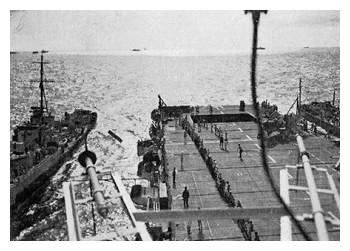 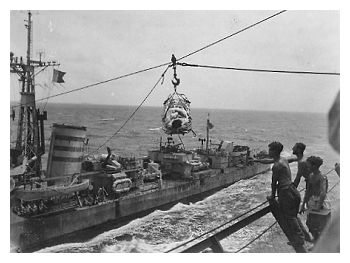 |
Replenishment at sea - stores and fuel are transferred
while underway, stores via light Jackstay (right), fuel
via hoses streamed astern. Teams of hands are needed to
man handle stores on and off the ship in dangerous
conditions as two vessels receive replenishment at the
same time (left). Photos: Left History of HMS
Speaker, Right from the collection of John Bryden Watt,
via Navsource. |
Replenishment period 16, July 26 – 27: TF 37 began oiling at 09:00 from the Tanker Group OLNA, CEDARDALE, CARELIA, EASEDALE, and WAVE GOVERNOR. Other ships took on stores from the VSIS GLENARTNEY, Armament Store Issuing Ships ROBERT MAERSK and CORINDA. The LSG comprised of
RULER (CAP & ASP), SPEAKER and
STRIKER (Replenishment), escorted by light cruiser ARGONAUT, destroyers NORMAN and NEPAL, sloops CRANE, PHEASANT, WOODCOCK and REDPOLE, frigates ODZANI and DERG and minesweeper PIRIE. Fuelling continued through the day and replacement aircraft and pilots were transferred to the carriers. The cruisers ACHILLES and NEWFOUNDLAND were detached to fuel from US TU 30. TF 37 disengaged at 18:50 for the night.
Fuelling resumed at 05:15 on the 27th.
STRIKER transferred her remaining 3 replacement aircraft to SPEAKER and dethatched for Guam on route to Manus. On completion of fuelling TF 37 set course overnight for the next morning’s flying off positions.
Replenishment period 17, July 31 – August 2:
TF 37 met with the Tanker Group OLNA, CARELIA, WAVE GOVERNOR and WAVE KING in replenishment area British Tizzy, approximate position 28° 4’ N 139° 00’ E, and oiling began at 10:00. The LSG comprised of
RULER (CAP & ASP), SPEAKER and
CHASER (Replenishment), the VSIS GLENARTNEY, ASIS ROBERT MAERSK and CORINDA, and the Radio and Radar Repair Ship
ARBUTUS. They were escorted by destroyers NORMAN and QUEENBOROUGH, sloops CRANE, PHEASANT, WOODCOCK and REDPOLE, frigates ODZANI and DERG and minesweeper PIRIE. Fuelling continued through the day and replacement aircraft and pilots were transferred to the carriers. TF 37 disengaged at 18:50 for the night and changed course to the south to avoid the tail of a typhoon due to pass to their north.
On completion of flying operations SPEAKER, in company with HMS QUEENBOROUGH, took passage to Manus for replacement aircraft, embarking Rear-Admiral J. H. Edelsten, C.B., C.B.E. (R.A. (D)) and Rear- Admiral R. M. Servaes, C.B.E. (C.S.2) via by jackstay transfer for passage, with their staffs. The passengers disembarked at Manus on August 7th and SPEAKER set about exchanging her airframes. SPEAKER sailed on August 14th for her last run to the replenishment area off Japan.
By this time the British pacific Fleet had carried out a third series of strikes against mainland Japan on August 8 – 10th and it was planned to withdraw for Australia on completion; the focus of the US Third Fleet Commander however had changed to attack targets in both northern Honshu and Hokkaido, the northern Island of Japan on August 10th, replenish on the 11th and conduct two more strike days on the 12th & 13th. This extension to the programme was problematic for the BPF as the LSG was scheduled to make one final replenishment on August 11th after which the LSG and Tanker Groups were executing the plans set out to prepare for the upcoming Operation OLYMPIC, the Invasion of Japan, so no Tanker support would be available and the US Logistic Group was already fully committed.
Vice-Admiral Sir Bernard Rawlings, 2 IC, BPF proposed a solution, a token force comprised of KING GEORGE V, INDEFATIGABLE, GAMBIA. NEWFOUNDLAND, TROUBRIDGE, TERMAGANT TENACIOUS, TEAZER, TERPSICHORE, BARFLEUR. NAPIER. NIZAM, WAKEFUL, AND WRANGLER was to remain in the operational area for strikes against Japan with the US Third Fleet. At 12:00 on August 12th Task Force 37 was dissolved and the bulk of the BPF set course for Manus, and then on to Sydney; the remaining Force were now attached to US Task Force 38 and designated as Task Group 38.5.
INDEFATIGABLE launched her last air strike against targets in the Tokyo area at 04:00 on the morning of August 15th, the order to suspend offensive operations was given at 07:00 when it was clear that Japan had surrendered.
Japan surrenders, fleet replenishment continues
SPEAKER was on passage to area 'British Tizzy' when the Japanese surrender was announced; by this stage in operations the replenishment CVEs had also been employed in carrying essential stores and provisions for issue to the fleet and for this run SPEAKER carried 350 packages of stores, 237 oil hoses and 15 tons of potatoes all of which were issued by jackstay transfers at sea. Although offensive operations had ceased replenishment work was still necessary, a large part of the stores carried were destined for the hospital ship TJITJALENGKA, 246 items of stores were transferred in a two and a half hour replenishment session in area 'British Tizzy'.
Replenishment period 20, August 18 -20:
TG 38.5 met the LSG in area ‘British Drink’ on the morning of August 18th and fuelling commenced from the Tanker group SAN ADOLPHO, SAN AMBROSIO and WAVE GOVERNOR, it continued throughout the day, the Fleet disengaging at 17:00 when SAN ADOLPHO and SAN AMBROSIO escorted by USK detached for Leyte. Fuelling continued from WAVE GOVERNOR on the 19th. SPEAKER, escorted by QUEENBOROUGH, arrived on station on the 20th and was ordered to transfer as many aircraft as possible to INDEFATIGABLE and
RULER. Ten Seafires and one Firefly were transferred to INDEFATIGABLE and one of each type were embarked as flyable duds, the remaining serviceable planes were flown off to
RULER. Signals were received asking how many extra officers and men could be accommodated, having transferred the majority of her aircraft in order to make more space; SPEAKER was to be an accommodation ship for the evacuation of POWs from camps on mainland Japan.
Tokyo Bay and the rescue of POWs: August 30th
- September 3rd
The Logistic Support Group maintained station in the replenishment
area waiting for orders to move inshore; the first elements of the
allied fleets entered Sagami Wan and later advanced into Tokyo Bay
on the 27th. The support group received their orders to proceed to
Tokyo Bay on the evening of the 28th but the following morning
SPEAKER, escorted by DERG, was ordered to proceed to Tokyo Bay with
despatch, independent of the other vessels of the support group. On
reaching the coast SPEAKER was joined by the Destroyer USS
FRANK KNOX which signalled further instructions, "You are instructed
to proceed to Tokyo Bay at earliest time possible and report to Com.
3rd Fleet."
SPEAKER entered Tokyo Bay early in the morning of
August 30th, she did so in peace time 'dress ship' routine with
white line of men fallen in the whole length of the flight deck, and
with the ship's "band"playing - she was the first allied ship to do
so, all vessels entering before her did so at full action stations.
She was the first allied carrier to anchor in Japanese waters. The
next day HMS
RULER arrived and all of SPEAKER's air maintenance
personnel transferred to her to maximise available accommodation
space.
|
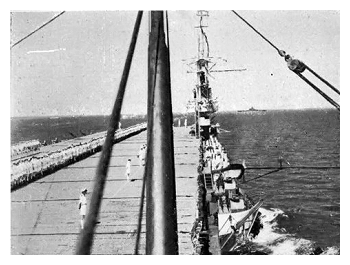 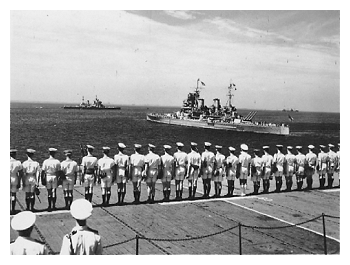 |
HMS SPEAKER enters Tokyo Bay observing peace-time
protocols, members of her crew lining the flight deck in
tropical white rig. Photos: Left History of HMS
Speaker, Right from the collection of John Bryden Watt,
via
Navsource. |
By this time it had become clear that the ship
was being prepared for humanitarian missions and every available
bunk, hammock and camp bed was to be made available for allied POWs who
were being liberated from the camps on the Japanese mainland.
Liberated prisoners were taken from camps in the interior to
Yokohama where hospital ships, billeting accommodations, and food
supplies were available. Instructions as to what to do next were
received from the commander of Task Group 30.6 (CTG30.6), a unit of
the 3rd Fleet formed to liberate, evacuate, and care for Allied POWs
in Japan which arrived in Tokyo Bay on August 29th. Speaker was to
move to berth 293 and by dusk she was in position and anchored.
SPEAKER was now amidst the vessels of the
American 'Rescue Group' moored off Yokohama; the hospital ships
USAHS MARIGOLD, carrying the 42nd General Hospital and USNHS
BENEVOLENCE and the fast transport USS GOSSELIN were among them and
they had been processing rescued POWs from the camps in the Tokyo
area. Within five minutes of dropping her anchor landing craft from
USS GOSSELIN began arriving alongside SPEAKER carrying POWs who were
deemed fit enough for travel, a process that was to be repeated
throughout the night. These men were mostly British servicemen from
all three fighting services and the Merchant Navy, there were also
commonwealth servicemen including Africans and Indians; all were
dressed in an assortment of donated items of US military clothing,
and a large number of the firearms, swords and other war-like
trophies also came aboard with the passengers and these had to be
taken into custody for the duration of the voyage. By noon the next
day (September 1st) 54 officers and 423 other ranks had been
accommodated.
|
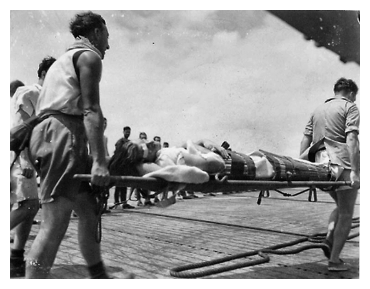 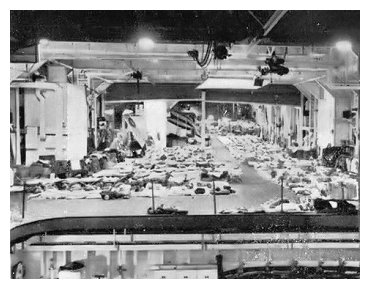 |
Rescued POW Stretcher cases were accommodated on the
hanger deck as well as in the small sick bay and
infirmary. The more mobile 'passengers' were
accommodated in crew spaces and anywhere a camp bed
could be put up. Photos: Left from the collection of
John Bryden Watt, via
Navsource, Right the History of HMS Speaker. |
Later that day the ship was moved again to
another distant anchorage in order to clear the Yokohama anchorage
for the capital ships of the combined Fleet in preparation for the
signing of the surrender documents. SPEAKER was still at anchor when
the signing ceremony took place on board the USS Missouri on the
2nd, a church service of thanksgiving was held aboard SPEAKER so
that crew and passengers could give thanks. Later in the day orders
were received from the BPF Flag ship HMS KING GEORGE V ordering her
to sail on the afternoon of September 3rd.
The evacuation of POWs, Tokyo to Manila:
September 3rd - 16th
At 1300 on 3rd September HMS SPEAKER left her mooring, she was the
first allied ship to depart the area, all her passengers were fallen
in on the fore end of the flight deck and the ship's company abaft
them, and prepared to set course for Manila. The passage through
Tokyo Bay was 12 miles but every ship in the Bay had cleared lower
deck and was standing by to cheer as she steamed by, her 477
passengers cheering and waving back, the ship wove in and out of the
mass of ships at anchor, passing as close as the ship's navigator
dared to each.
|
 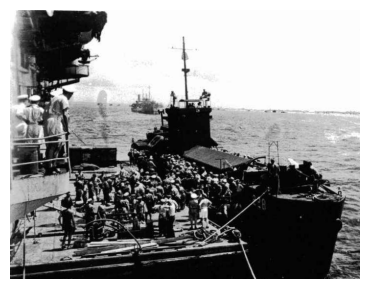 |
Left: The flight deck scene as SPEAKER made her way
trough the assembled ship of the allied fleet out of
Tokyo Bay as ship's company and rescued POWs cheer and
wave to each ship they pass. Right: Disembarking the
rescued men onto landing craft for ferrying ashore at
Manila. Photos: from the collection of Bernard
Stogdem. |
SPEAKER took passage to Manila in company with
her escort HMS DERG and a tanker, RFA WAVE KING. The tanker had to
leave the small convoy and divert to Okinawa with machinery
problems, leaving SPEAKER and DERG to continue on to reach Manila 0n
September 9th. During he voyage each passenger was issued with
currency, 5 Australian pounds and 4 American dollars (= 5 Pounds
Sterling), so that wherever they fetched up they would money to
spend.
After safely depositing the passengers at Manila
SPEAKER spent the next two days refuelling and storing ship in
preparation for a second rescue lift sailing on September 12th
escorted by the USS WEEDEN. This time she was ordered to enter the
harbour at Nagasaki were she anchored September 16th to collect
rescued POWs from Fukuoka prison camps in that area.
The evacuation of POWs, Nagasaki to Okinawa:
September 16th - 25th
As at Tokyo hospital ships were caring for the most serious cases,
the USNHS HAVEN was in Nagasaki harbour and SPEAKER began receiving
stretcher cases and other cases fit for onward passage to shore
based hospitals in Okinawa. SPEAKER's departure was delayed until
the 18th due to a Typhoon which hit the area on the afternoon of the
17th, this blew over quite quickly but no before causing damage and
mayhem for the ships riding it out at anchor. The following morning
the commander of the Nagasaki Rescue Group, Rear-Admiral F. G.
Fahrion USN, visited SPEAKER and was quite surprised to learn that
the ship had faired much better than many of the others in the
harbour and would be ready to sail that afternoon. By the time she
was ready to sail she had a staggering 899 passengers on board; men
overflowed into passage ways and some even slept in a magazine which
would have been most unsuitable in bad weather.
|
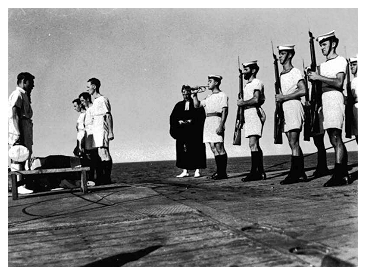
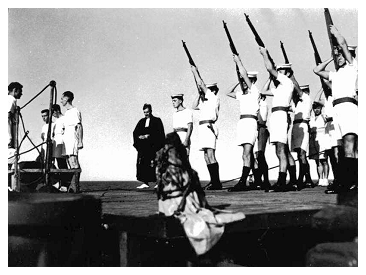 |
The burial at sea of Staff Sergeant Harry Stogden RAOC,
he was laid to rest at 16:35 hours on September 18th
1945 off the Japanese coast. Photos from the
collection of Bernard Stogden.. |
Shortly after departing for Okinawa a former POW,
Staff Sergeant Harry Stogden of the RAOC, was buried at sea with
full honours. He had been cared for aboard the American hospital
ship USNHS HAVEN after his rescue from Fukuoka 3-B POW camp but died
from Beri Beri, his body was transferred to SPEAKER for a burial at
sea. The ship arrived at Okinawa on the 19th and discharged her
passengers at Hagushi Bay.
|
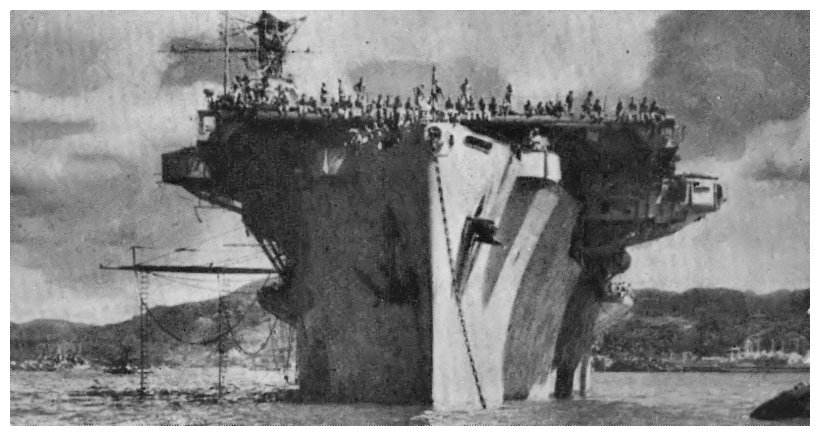 |
During SPEAKER's second visit to Nagasaki harbour
members of the ship's company and some of the more
mobile rescued POWs gather on the flight deck< while
waiting for more passengers to embark. Photo::
Author's collection |
|
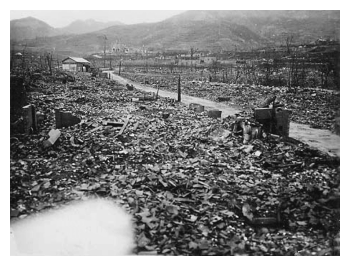
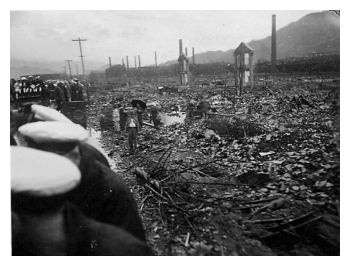 |
The devastation that was Nagasaki as seen by members of
the ship's company on tours through the city on army
lorries. Photo:s from the collection of John Bryden
Watt, via Navsource. |
After leaving her passengers
at medical facilities on Okinawa SPEAKER immediately returned to
Nagasaki arriving on the 21st.On this occasion there was time for
many of the crew to take the opportunity to see the devastation of
the atom bomb before boarding the next batch of passengers. Unknown
to these 'sightseers' was the seriously dangerous levels of
radiation that remained in the ruined city and surrounding area
through which they were ferried in open topped Army trucks. (See
photos) For her last run to Okinawa she embarked eight officers and
633 other ranks, and sad sailed on the 23rd, arriving there the
following day. This time she left Okinawa for Hong Kong on 25th,
arriving 28th.
Hong Kong to Sydney via Manila: September 28th
- October 15th
On leaving Okinawa on September 25th SPEAKER steamed for Hong Kong
where she was to replenish her severely depleted stores and refuel
in preparation for a trooping voyage to Sydney via Mania. She
arrived in Hong Kong on the 28th and was ready to sail again on the
30th. Arriving at Manila on October 2nd 556 Australian ex-POWs
embarked for repatriation; these men had been recuperating onboard
Hospital Ships such as the HMHS Tjitjalengka, sand were a much
fitter lot. After some delays in embarking the passengers SPEAKER
set sail on October 4th and made best speed for the Australian
coast.
While still at sea off Brisbane on October 14th
the captain ordered the ship to be 'spruced up' in preparation for
entering Sydney harbour; many of the Australian passengers
volunteered to help out and a quick coat of paint was applied to
conceal the ravages of three months at sea. SPEAKER entered Sydney
harbour on October 15th, and berth at No. 14 Pyrmont at 8.45 a.m.
Once unloaded the ship moved to a mooring in mid-stream off
.Bradley's Head to begin a planned three week period of defect
rectification during which time seven days' leave as granted to each
watch.
In dockyard hands at Sydney: early November to December 26th
The ship was ready to resume her trooping runs to Hong Kong on early
November but just prior to sailing a corroded pipe burst in the Diesel
dynamo room and flooded the compartment. This latest defect was to
require extensive repair work on the dynamo armatures so the ship
remained in dockyard hands while repairs were affected. During this
unplanned stay the opportunity was taken to complete the ships'
repaint and her peacetime scheme was reapplied the ships' company
also held two dances on board, music for dancing was provided by the
Royal Marine Band from HMS GOLDEN HIND while guests arrived by naval
cutters from the Taronga wharf as she was moored in mid-stream.
The repair work was slower than expected because
it coincided with a wave of strikes ashore which had Sydney
residents being deprived of power for lighting, cooking, transport
and entertainments; the strikes also made it difficult for many men
to get away on their extra leave. The ship was not ready until
Boxing Day, the crew having spent Christmas in and around Sydney but
it was now time to resume ferrying passengers and equipment. By this
time the 30th Aircraft Carrier Squadron was disbanded and all but
SPEAKER and VINDEX remained with the reduced BPF for transport
duties, the other vessels of the squadron had been reassigned or
returned to the UK. In addition to the squadron disbanding many of
the ships' key personnel were leaving to return home under the 'age
and Service Act' which was passed in the UK after V-J Day; the act
was demobilising the armed forces at an alarming rate at a time when
manpower was still desperately needed for the major tasks of
reorganising resources and materials needed for the transition from
wartime to peacetime.
Ferry trip to Hong Kong: December 26th -
January 30th
For this, the outward leg of a round trip to Honk Kong SPEAKER's
passengers were a mixed bag of service personnel and civilians,
including the magician "The Great Levante"and his concert party who
had been performing for servicemen in Sydney and were now going to
entertain the forces in Hong Kong. Her first port of call was
Brisbane to load more passengers, a number of heavy vehicles and the
personnel, equipment and 10 Vengeance Target Tug aircraft of 721
naval air squadron on December 28th. This squadron was a Fleet
Requirements Unit that had operated at RNAS Ponam in the Admiralty
Islands that had been evacuated to the RN Aircraft Maintenance Yard
at Archerfield, Brisbane, in October where it regrouped and
re-equipped. Also embarked were a ten-ton crane, 4,076 items of
stores and 38,400 bottles of beer all of which loaded her to
capacity, a large part of the flight deck being taken up with a
lorry park.
The concert party soon got busy with rehearsals, using a 7-ton van
placed forward on the flight deck, and eventually they were able to
put on two shows on a stage erected on the flight deck on the only
two nights which the weather permitted. The voyage was to be dogged
by foul weather for most of the time and concerns were expressed on
several occasions about the safety of the vehicles lashed on deck.
The ship called at Manila to refuel on January 7th and to embark
more passengers for Hong Kong were embarked, amongst these was
Captain B. L. Moore, R.N., the Senior British Naval Liaison Officer,
Philippines, and his staff, their job of liaising with the American
forces now completed. SPEAKER sailed the following day and reached
Hong Kong on January 10th.
After unloading and making good storm damage SPEAKER sailed for the
return leg on January 17th with more passengers and proceeded to the
Admiralty Islands to embark servicemen and women for passage to
Sydney. The call at Manus was brief, only long enough to embark the
extra passengers bringing her total for the trip to 459 passengers,
most of who were due for release. She arrived in Sydney on January
30th after again suffering monsoon conditions for most of this
journey.
|
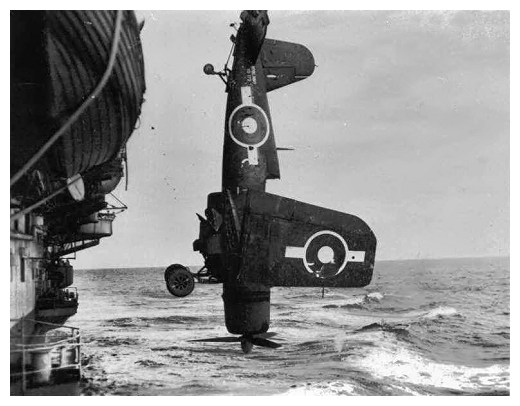
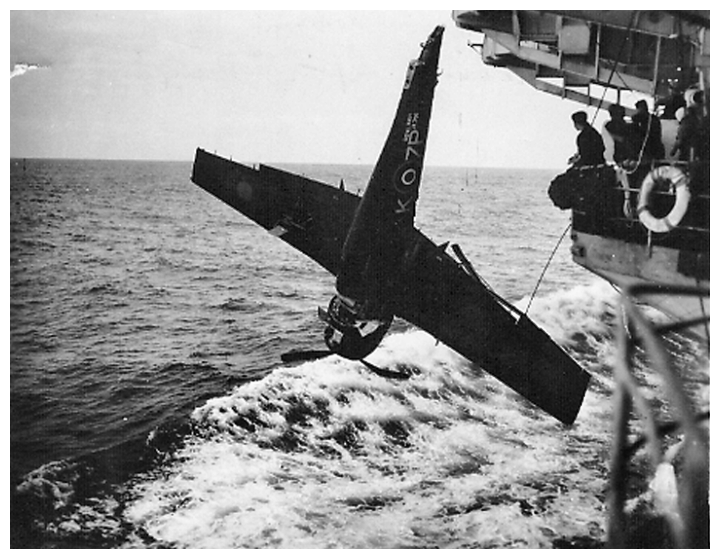 |
Surplus and 'beyond repair' airframes were routinely
ditched over the side. During hostilities unsalvageable
ones were stripped of usable spares first and the
carcass ditched (right), after the end of hostilities
complete aircraft were ditched in their hundreds.
Photos: Right; from the collection of John Bryden Watt,
via
Navsource, Left;
from the collection of Bernard Stogden. |
Ferry trip to Hong Kong: February 12th- March 16th
1946
HMS SPEAKER left Sydney for a final round trip to Hong Kong on
February 12th and proceeded to Manus where she stopped for three
hours to collect passengers on the 18th. She arrived in Hong Kong on
February 25th, and was to spend the next seven days loading
passengers, stores and surplus airframes from
HMS Nabcatcher,
the RN Air Station at
Kia Tak airfield. SPEAKER
sailed for Sydney for the last time on March 4th and five days out from Hong Kong the airframes were ditched overboard; these were mainly
American types of aircraft which had been transferred to the Royal
Navy under the Lend-Lease agreement between the US and Britain.
Under the terms of the agreement once the war was over the equipment
would be returned or paid for, operational losses were not expected
to be paid for so many hundreds of 'serviceable' aircraft were
thrown overboard in the Pacific, neither the US or Britain wanted
them back. SPEAKER arrived back in Sydney on March 16th and began
preparations' for her return voyage to the UK.
Homeward Bound, Sydney to Greenock: March 26th
- May 24th 1946
HMS SPEAKER said farewell to Sydney on March 26th 1946 and began the
long voyage home to Britain. Amongst her stores she carried 2,500
cases of jam from the Food for Britain Fund for free distribution to
the people of Great Britain. The ship's Canteen Committee donated
£125 to the fund. The first leg of her voyage was back to Hong Kong
calling at Brisbane on the 29th and Moratai on April 4th, spending
only a few hours at these ports. She docked in Hong Kong on April
9th and was to spend eleven days there exchanging personnel and
stores; on the 19th she embarked a Japanese one man suicide torpedo
for passage to the UK for further study, she sailed the following
day bound for Colombo.
|
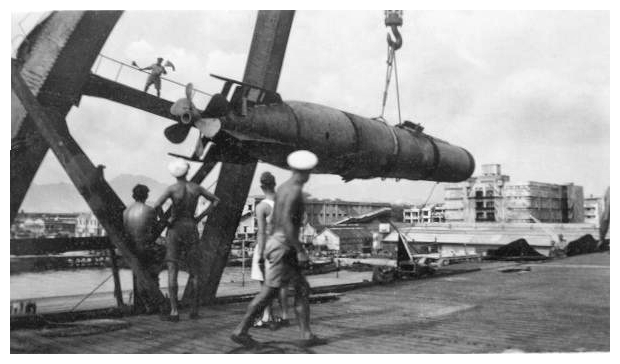 |
Hoisting a Japanese one man suicide torpedo aboard at
Hong Kong. Photo: From the collection of William T.
Sallows, via
Navsource. |
SPEAKER passed Singapore and entered the Malacca
Straits April 25th, arriving at Colombo 30th. The ship took on
stores, fuel and more passengers before continuing on for Aden, her
next refuel stop on the 8th. After transiting the Suez Canal SPEAKER
arrived at Port Said on the May 14th, she was to spend only 4 hours
in the port before entering the Mediterranean and setting course for
Gibraltar where she was to make an even briefer call on the 20th.
HMS SPEAKER arrived on the Clyde on May 24th and after unloading her
passengers was moored at Greenock.
Disposal: Return to US Custody
After Greenock SPEAKER was to be destored and many items Admiralty
equipment was removed in proration for her return to the US
authorities, her role with the Royal Navy having come to an end. She
sailed from Greenock for the last time on July 6th 1946 bound for
the US Naval Dockyard at Norfolk, Virginia but had to call into the
in RN Dockyard Bermuda to carry out boiler repairs before continuing
on to Norfolk where she docked on July 17th and was paid off as a
Royal Navy vessel.
CVE-40 was returned to US Navy custody on July 27th 1946 and no longer required for service by the US Navy she was placed on the disposal list on September 25th 1946. She was sold to Dodero Navigation company on April 22nd 1947 and converted to merchantman LANCERO by the Newport News Shipbuilding & Drydock co. and was delivered February 9th 1948. In 1965 she was sold to the Philippine President Lines and renamed PRESIDENT OSMENA; she was sold for breaking in 1971 and bore the name LUCKY THREE for her delivery voyage to the breaker. She was scrapped at Kaohsiung, Taiwan in 1972.
|
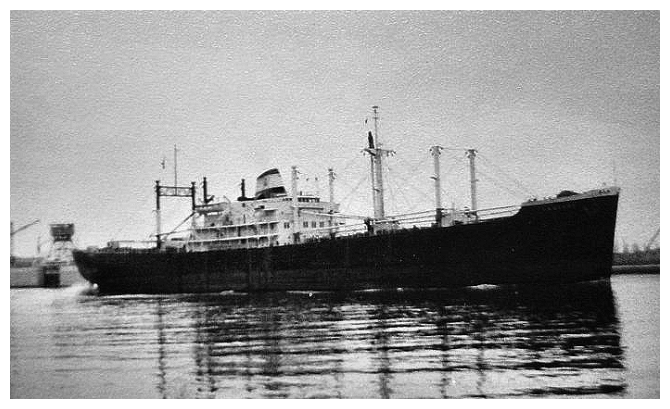 |
"Swords into ploughshares " HMS SPEAKER post war as the
mercantile vessel S.S. LANCERO Photo: Gerhard
Mueller-Debus via
Navsource |
Content revised:
28 December 2021
Sources used in compiling this account:
Click here for a list of
Primary sources
Additional sources:
HMS Speaker, (1946) 'History of HMS Speaker' Sydney,
The Pinnicle Press
Fold3.com various documents including;
Admiralty War Diaries
US Naval Station, Seattle, Washington
US Naval Station, Manchester, Washington
Puget Sound Navy Yard War Diaries
US Thirteenth Naval District War Diaries
Norfolk Navy Yard War Diaries
Mew York Navy Yard War Diaries
Miscellaneous documents
Special thanks to Fabio Peña,
Manager, Aircraft Carriers & Escort Carriers Archives at
NavSource.org
for his assistance with
contacts and resources.
|
Home
page |
go to the top
|
Comments (3)
Does anyone have any information on Maurice Evelyn Sier? Did he leave the RNVR in Sydney after VJ-Day?
My father served as an able seaman on the speaker in ww2 Cliff England. He played in the ships band as the drummer. He moved to Australia after the war ended
Hi does anyone have any info/photos of Arthur Gregory?